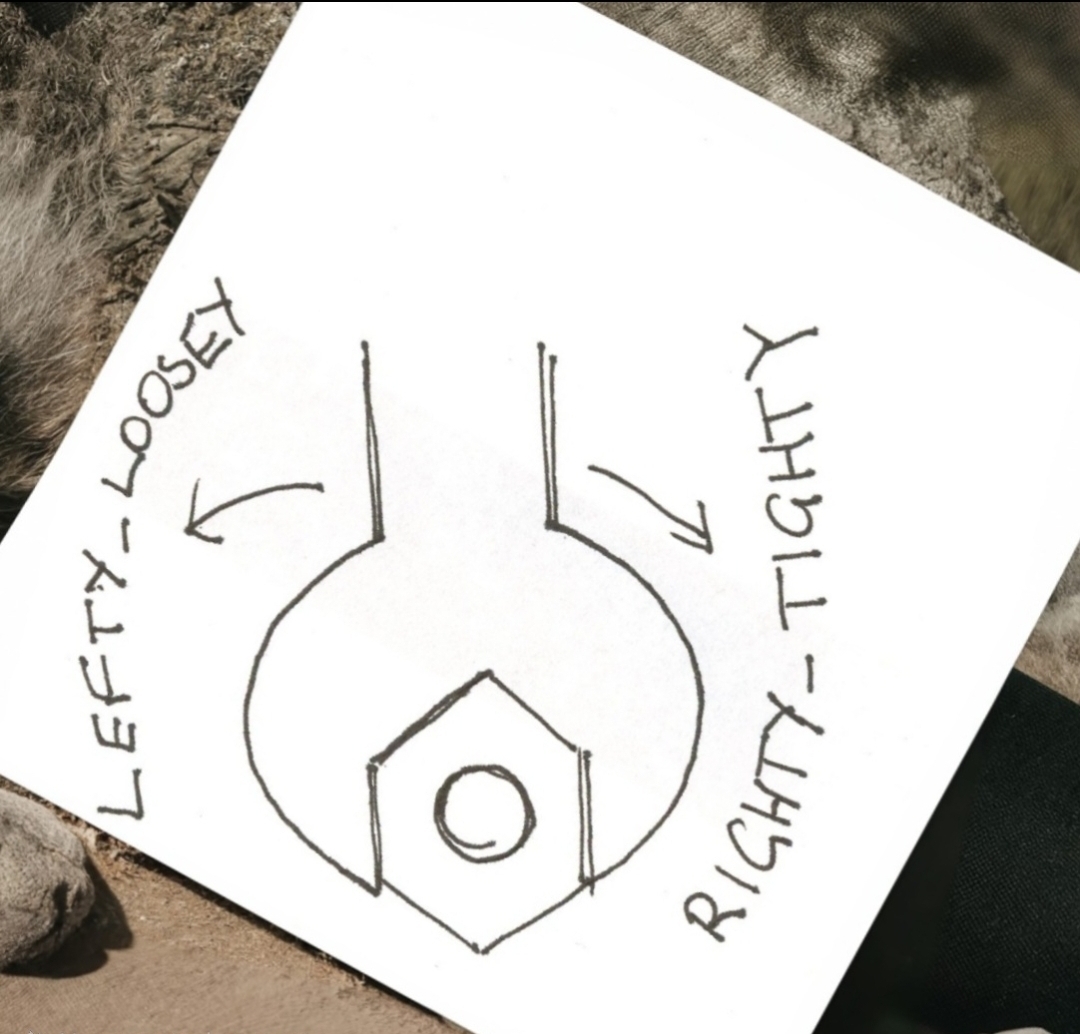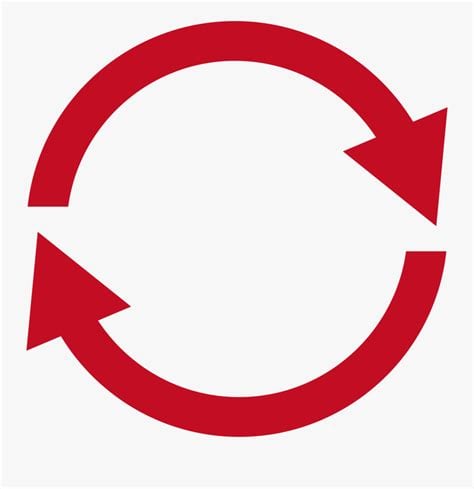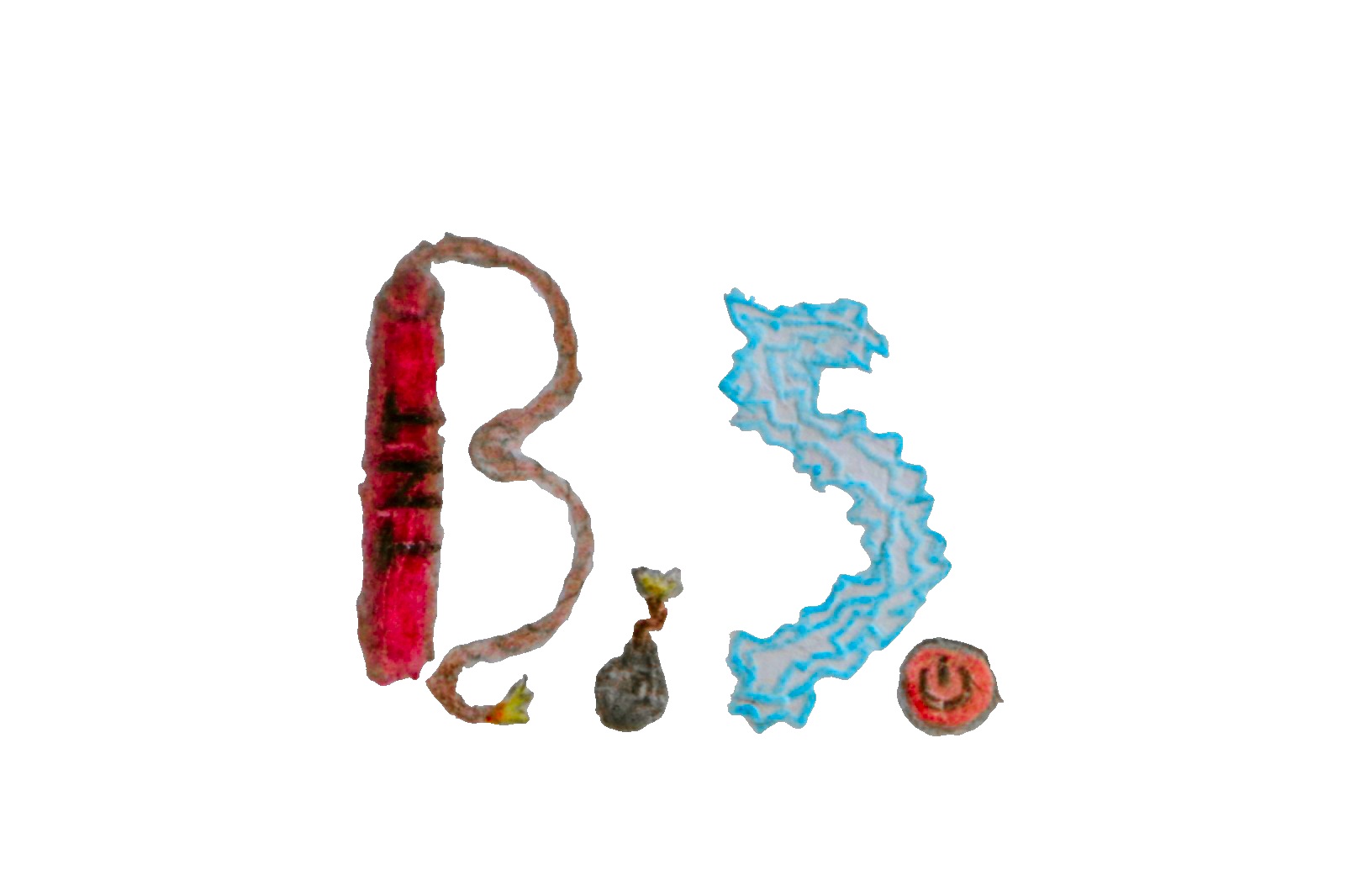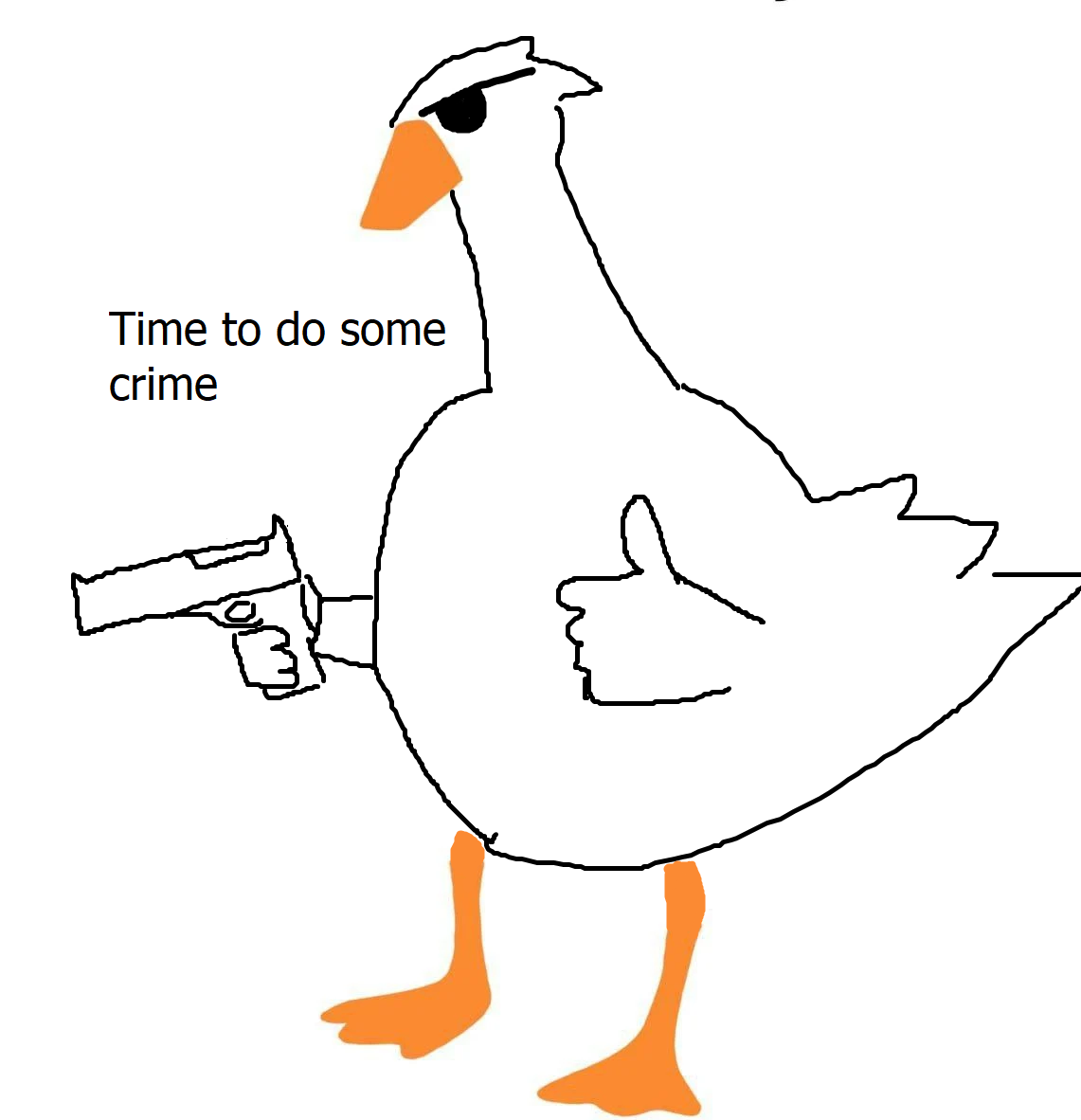The world has a lot of different standards for a lot of things, but I have never heard of a place with the default screw thread direction being opposite.
So does each language have a fun mnemonic?
Photo credit: https://3.bp.blogspot.com/-Giy8OrYJTjw/Tfm9Ne5o5hI/AAAAAAAAAB4/c7uBLwjkl9c/s1600/scan0002.jpg
The Spanish version is my favourite: la derecha oprime y la izquierda libera (the right oppresses and the left liberates)
Oh wow that one is really good :D
BASED
I’m using this in every language I speak from now on!
I had never heard that before. Is that a region or country-specific thing?
Definitely not a common phrase. I’ve never heard of it (from Spain) and I just asked about 10 others from other countries and only one has. We usually would just say clockwise or counterclockwise
Isn’t everything in Spanish?
Holy shit, fucking hell, now this is some goddamn wordplay!
I’m stealing this like the fucking British Museum.
I think I saw that on reddit 2years ago, thank you for reminding me how’s the actual saying (I ~have adopted ever since I saw it, lol)
¡Gracias por la lección de español de hoy!
I don’t speak Spanish, but is there a reason this works well as a mnemonic? Like is there a reason you can’t misremember it as la izquierda oprime y la derecha libera? Because the English phrase works by alliteration.
Edit: i guess if you think of it in terms of politics that helps
That’s awesome.
The right oppresses, the left liberates

Lmao
Ah yes the famed spaniard mao
“La derecha oprime y la izquierda libera”
The right oppresses, the left liberates
La derecha oprime y la izquierda libera
I just knew that would be Spanish, without being able to speak more than a few words. It works far better than our effort and is both a sardonic and satirical political comment.
Well played Spanish if that really is the equivalent in common usage. Our effort sounds like it was invented by a young child whilst responding to a BBC quiz.
I’ve never heard this, But it’s great
I love Spanish, damn that’s a good way to say it.
Never heard of that. When attending a trade school there was never the necessity of a mnemotechnic to know in which direction turn the tool.
As other mentioned this kind of phrase is useless if you are in the opposite side of the thing you want to tighten/loose.
What I always heard is “la regla del destornillador” (the screwdriver rule), as a substitute for the right hand rule.
People on the other side don’t deserve a mnemonic.
We say the same thing in Brazil, but in portuguese: “A direita oprime, a esquerda liberta.”
In austrian german dialect, “Mit da Ua, draht ma zua.” which in standard german would be “Mit der Uhr, dreht man zu.” and in english “With the clock, turn it closed.” or something like that.
Neat. Would be engineering related lol
In English, there’s also “clockwise-lockwise”. It makes more sense than talking about left and right.
I’m gonna try this with my son, he knows with way clocks go better than his left and right.
Da scheißt di au!
Interesting. I learned it as “Wie die Ua, so gehts zua”
I never really got that one, because “left” vs “right” only works when you are looking at the top of the screw. At the bottom, left tightens, and right loosens. So the one I remember is “clockwise to close”.
Edit: the image on the post is actually a good example. If I’m off the screen to the right holding the spanner, then from my perspective, “left” would tighten.
I’ve always thought this too. I understand clockwise/anticlockwise and the direction being defined from the top - but it’s a circle - no matter which way you turn, it spends 50% of the time going either direction. The phrase works with screwdrivers (especially ratcheting ones), but not so much spanners or Hex Keys IMO.
I always railed against this. I’m using clockwise-lockwise from now on.
Agreed. If the screw moves left or right, it fell out of its hole, lol. I guess “clockwise” is hard to rhyme.
It works for screws, but as a kid, I was never sure if the clock on the wall should be visualized attached to the ceiling or on the floor when saying “clockwise”. So I was always a bit hessitant on that.
I explained here, but that’s why I prefer using the right-hand-rule. Sometimes thinking about clockwise in strange frame of references hurts my little brain.
If you mime tightening a bolt, your thumb moves to the right. And vise versa.
Left or right-handed?
Both. Odd that you would ask without trying it yourself.
With my left hand, my thumb starts facing right, and then sort of goes down and towards the left.
Am i weird if i tighten bolts by moving my fingers up/down intsead of side to side?
Nah I do the same till it’s loose, it’s faster to rotate with minimal rotation. But once it get harder then I do slower but larger rotations with thumb starting from left side and goes towards right for like 120°.
In Dutch we have DROL, Dicht recht, open links. So close right, open left as a very strict translation. But DROL is also Dutch for turd.
A droll factoid.
Never heard of that, I just remembered from my dad that clockwise is tight and counterclockwise is loose.
Same here, except for my dad, he is clumsy as hell.
Huh, I always say links los, rechts rotsvast
Edit: or, this: links verlost, rechts rekent in
Not for screwing/unscrewing but in France we have a satire mnemonic for remembering right and left:
The right hand is the one with the thumb pointing left.
Works only if you look at the back of your hands, and obviously not useful. We use it mainly to mock someone who mix right and left
In English we’ll say, “Your other <right/left>”, depending on which direction the person is messing up.
I think that one is universal
It ain’t.
What’s the phrase in French?
La main droite, c’est celle qui a le pouce à gauche
Not sure about the thumb one but for screws with only have:
- Visser : sens des aiguilles d’une montre (clockwise)
- Dévisser : sens contraire des aiguilles d’une montre (anti clockwise)
We got that one in Germany as well
Dad? Is that you ?
I’ve never heard something like this
Are there lots of French who can’t easily tell left from right? I feel like one of the few sad Americans who can’t. Would love to know why. I always chalked it up to a lack of coordination.
I’d say as many as in other countries
I’m Norwegian. I never learned a rule in my language and always just went by instinct. Until ~3rd year of university in physics where someone told me tha the right-hand-rule applies to screws. Now I use that everywhere for screws in strange positions.
Well, this was a life-changing comment.
Can you elaborate? I googled the right hand rule, but I’m not seeing how it applies to screws.
Grab around a screw with your right hand and extend your thumb (like a thumbs up). Then rotating the screw in the direction which your fingers are pointing will result in the screw moving in the direction your thumb is pointing.
Thumbs up for lifting the screw upwards, thumbs down for screwing the screw downwards. And you can move your hand around to figure out screwing directions for any tricky spots.
Beware the left handed screws, they’re around but rare. My last encounter was inside a vacuum cleaner motor assembly.
Propane and propane accessories also use left-handed threading. It can be really weird to get used to after a lifetime of righty tighty.
This guy Hanks.
Great explanation, thanks
I’m indian and learns right hand screw rule in high school physics
I’ve heard the right hand rule regarding magnetism and current direction (because it’s useful to illustrate correlation between vectors), but never about screws. Now that I think of it, it makes perfect sense there too, only that you have to imagine a thumb pointing down most of the time…
You know this has always confused the fuck out of me. You are going around a circle, how is there left and right? There is up-and-left, down-and-left, either way is left. If I am starting on the right of the circle (assuming I’m looking at it) which way is right? Up or down?
Imagine it like a car steering wheel.
You’d say turning the wheel to the right turns the car right.

Think of it like this. Like your hand is holding on the top of the steering wheel.
ok but what is behind this picture? I see fur and old matted flesh? a paw with no nails or an old dogs snout?!?!
It’s better to not ask questions sometimes.
backs away slowly
Clockwise = Righty
Or imagine a bottle cap instead of a screw… Muscle memory kicks in.
Thank you! Clockwise looking down at a bottlecap makes sense!
The starting point is on the top.
This has always annoyed me too. I know why it works, but it’s clockwise and counter-(or anti-)clockwise. If you were turning from the bottom, left and right are mixed up. Maybe it’s just too hard to come up with a phrase using those terms?
Clockwise=lockwise
I always think about the direction that the top of the circle turns to apply left or right rotation, though I usually use muscle memory.
If it was a wheel, which way would it roll if you turned it like that?
It’s the top part. So if you imagine a little dot at the top (12h) position it would move to the right/clockwise or left/anti-clockwise
Yeah, but once you get one quarter of a rotation through your dot is now moving left.
But the top is still moving right
Use right hand thumb rule. There is no right, there is no left, there is no clockwise or anticlockwise. All of them depend on the way you looks. Rught hand thumb rule fixes it for humans
The German version as actually survived its original time frame: “So lang das Deutsche Reich besteht, wird Schraube fest nach rechts gedreht” - “As long as the German Reich exists, a screw is tightened by turning right”
yeah, this one is only for inside voice. I won’t be teaching it to anyone anymore.
I’m German, and I’ve never heard that before. I’d be seriously weirded out by someone saying that or teaching it to their kids
I have to admit that this is rather old. So old, in fact, that it does not refer to the Third Reich but the Kaiserreich.
That’s better but not that by much. A few years ago Germany raided some very rich and very well-armed wackos who wanted to bring back the Kaiserreich.
Just like a number of very rich and well armed wackos want to bring back Trump in the US.
German conspiracy wackos and American ones have a lot in common.
During COVID their bullshit ven diagram was a flat circle.
I don’t think anyone thought it was about the third reich
Probably someone did. Not all English-speakers know about the first two, or have thought to ask.
Yup this was me. I knew it was the third, but it never occurred to me to ask what the other 2 were
TBH I knew about the Kaiserreich, but I had to look up the first one myself. It was the Holy Roman Empire. (Which wasn’t really much of a reich, but the Nazis weren’t noted for their attention to historical accuracy)
I daresay that 99% of “English-speakers” never wasted a thought on why the Third Reich actually was the third.
And honestly, it could be that 90% wouldn’t know what the HRE was or who the Kaiser was once you told them. It’s just not a thing that usually comes up in everyday life.
Never underestimate the incompetence of people, especially in the US, with regards to history. Just look how they are basically trying to recreate Germany’s 1933 at the moment.
still mentioned twice in the thread. It‘s fucked up how often one would come across Germans casually throwing around Nazi language, looking for confirmation and when not receiving it claiming it’s just innocent fun. HiHiHi
Well, but is actually is not Nazi language in this case.
you think people don’t use it in that context?
also, because you‘re so adamant, I tried to find a source for your claim. I failed. Want to share?
My source is my grandfather, who learned this during his vocational training, which predates the Nazis by quite a few years.
So … shouldn’t German screws now turn to the left?
See!!! This is why communism is bad!! Since you’ve started turning everything to the left, it’s all come apart!!
Nar. A statement and its converse are not equivalent.
Never heard of this. We say ‘auf links, rechts zu’ and simply order the words alphabetically
Solang das Deutsche Reich besteht, wird die Schraube rechts gedreht.
That’s a lot of extra words for lefty loosey, righty tighty.
And how are we supposed to turn screws nowadays?
Your screwdriver subscription has expired.
Please renew your subscription today!
Don’t you dare give them ideas
Wenn das der Kaiser wüsste!
I guess we’re screwed
This phrase has never made any sense to me. It’s a circle. If one side is moving right, then the opposite side is moving left. So the phrase only makes sense if you specify which side we are talking about, which nobody ever does. Therefore it’s completely illogical to me while everyone else just gets it. Side note: Autism can be a real bitch sometimes.
Edit:
- Some people don’t understand how I can see a problem. That’s cool, but don’t be a dick. We all look at the world through different lenses.
- This is when I was a kid “helping” my grandfather in the garage. I’m older now and understand that “righty tighty” references the top of the rotation.
- Some people rotate their perspective 90° and imagine themselves standing on the screw. Therefore when your face rotates to the right the screw is tightened. I hadn’t ever thought of that. But I had imagined rotating my perspective 90° the other direction –the top of my head as a screwdriver. In that case, “lefty tighty”
Clockwise and counterclockwise may be more intuitive for some people. Is the clock-hand (wrench) going forward in time, or backwards. But I don’t know of any quick rhyme for that
Yes, that verbiage makes way more sense.
deleted by creator
Clockwise and counter-clockwise makes sense.
But when you say “right” it’s not clear which side of the circle is being referenced. If the top of the circle is moving to the right, the bottom is moving left at the same time. So the saying only makes sense when you specify that you’re talking about the top of the circle.
you have to have never seen a steering wheel to not understand which side of the circle is being referenced. it’s always the top. who would even reference anything else and why.
“turn it right”
“which part???”
“the middle of course, you absolute alien”
Because people get confused when there is no space for the wrench at the top, and they put the handle at the bottom and try to move the wrench left or right, not referencing the top of bolt.
Because they aren’t using the saying as a clokwise/counter clockwise reminder but as a flat out instruction.
I think we can all understand how it functions but that doesn’t make it “correct.” It’s spinning around a circle. Exactly half of its moving right as the other half moves left. That’s why we have the terms clockwise and counter-clockwise. If left and right were actually reasonable for something spinning in a circle this wouldn’t exist.
yes it would. we always have redundancy, especially in speech. also we’re not robots, technicality doesn’t matter, how we communicate does. do you get confused when people say something like “that’s all behind us now” meaning the past? do you literally turn around and argue that there’s nothing really behind you and they should have said in the past instead?
I don’t get confused by any of this. Stop pretending like everyone else is stupid. If you’re looking at the hands of a clock, they aren’t moving right when they’re moving clockwise half of the time. The applies to everything moving around a circle. Left and right are only useful if you’re looking at a specific segment of it. Clockwise is what we use for rotations everywhere else. For example, look at this wiki page that says this: “Rotation or rotational motion is the circular movement of an object around a central line, known as an axis of rotation. A plane figure can rotate in either a clockwise or counterclockwise sense around a perpendicular axis intersecting anywhere inside or outside the figure at a center of rotation.” Right is literally never even used in that page, and left is only used once. The terms don’t make sense for rotations. We can make up rules for how they can be considered for rotations, but they fundamentally are not words used to describe rotations. Do you get confused when people say there are more useful words to describe a function?
Yes, it’s always the top side of the circle in this context, or you can think about how clock hands do go in a specific direction, because they’re a radius, not a circumference. There, now it’s cleared up for you.
The clock hands move right when at the top but left when at the bottom.
In Australia, it’s the other way around and the clock will try to eat you or at least sting you to death.
Imagine it as if it were a track you were driving around, which way would you turn the wheel?
It’s getting so convoluted at this point just knowing clockwise/anticlockwise is infinitely easier.
Yes! That concept makes way more sense.
If a steering wheel has you this perplexed then I beg you to never ever drive a vehicle.
If you’re gripping the bottom of the wheel you move your hands left to make the car turn right. Which is kind of the whole problem here. Rotation around a centre doesn’t happen right or left. That’s the whole reason why the words “clockwise” and “anticlockwise” exist. Translation = right, left, up, down, forward, back. Rotation = clockwise, anticlockwise.
It doesn’t matter where you hold the wheel. When you’re turning right, you’re always doing the right movement for tightening a screw, no matter the hand position. That’s the point.
If I ask you to turn the car left and you give me this speech I would eject from the car.
Am I going clockwise or anticlockwise round the track?
So you’re explaining rotation, in terms of a smaller imaginary rotation, which engages with imaginary traction wheels, which engage with the work to be turned?
If that works for you, great, but it is complicated.
No im trying to illustrate the parallels between how you turn the wheel, how the car turns in response to that , and how they are all related. You turn left you will make the exact same rotational movement, with both the vehicle, and the steering wheel.
It’s as simple as, “What direction do you turn the wheel to make the car go left?” I just stacked on top “and also it makes the car itself do that same exact circular movement” so you don’t just dismiss this as some kind of arbitrary convention.
Oh, I see.
Car steering wheels work that way because of the convention. Change the side that the steering column’s pinion meets the rack and the wheel would work the opposite way. From the mathematical perspective, there’s two ways to continuously map an arc of the steering wheel to an arc of the wheels, and since they aren’t in the same plane neither is “wrong”.
i know you can make the wheel work the opposite way, jesus christ. the circle motion the path of the car makes when you turn left is the same as when you turn the wheel to the conventional left. imagine, instead you steered “left” by a joystick. the car would still draw the same circular path the same fucking way, because turning left makes an anticlockwise circle, every time, in every situation.
One of them is “wrong” and would kill many people
deleted by creator
What the fuck are you talking about.
You’re either rotating the fastener to the right or the left.
It doesn’t matter what side you’re talking about, because you’re not moving one side of the fastener, you’re rotating the whole thing one direction or the other.
Clockwise just means something is rotating to the right.
If I ask you to turn around to the right, are you going to ask me what side of you I’m referencing?

Here is clockwise. One arrow is going to the right and one to the left.
I tend to agree but you could argue that from a perspective in the center of the rotation you’re turning to the right. Imagine standing in the center of those arrows.
What happens if you look at it from the other side?
The whole thing is rotating to the right, that’s what clockwise means. Clocks rotate to the right. One arrow is not pointing left, it’s pointing in the direction of rotation, which is to the right.
The bottom arrow is, definitionally, pointing left.
deleted by creator
If you follow that arrow around to the next with your hand, which direction is your hand moving?
That is indicating clockwise rotation, or a rotation to the right. We’re talking about circles here
Is the direction of rotation in the room with us right now?
If I ask you to turn around to the right, are you going to ask me what side of you I’m referencing?
No, because humans have a pretty clear forward direction. Screws don’t. You say turn a screw to the right, do you mean make the top of the screw move right or the bottom move right?
Most people assume the top, but not all, and the language is ambiguous.
Slightly, anyway. If you’re both standing over the thing it can potentially be agreed on. If you’re all over the place working on some big machine you need to use some language, and I’m not aware of a standard way to do it.
The “front” or “forward” direction of a screw is clearly the face of the fastener itself, be it a hex head, Phillips, or Slotted screw. Picking a side of a face as the front doesn’t make any sense. The whole thing needs to rotate one direction or another, and it will either rotate to the right to tighten, or the left to loosen.
If I ask you what the front of a clock is, are you going to tell me it’s the top curve near the ceiling? No it’s the face of the clock, and the hands rotate around it to the right.
The “front” or “forward” direction of a screw is clearly the face of the fastener itself, be it a hex head, Phillips, or Slotted screw.
Correct.
Picking a side of a face as the front doesn’t make any sense.
Right. Nobody is talking about the under side of the fastener. Just looking it the face of the fastener, as one does when driving into something.
The whole thing needs to rotate one direction or another,
Wrong. A rotating circle rotates in all directions, including right and left, up and down, at the same time. If you attach an arrow perpendicular to the circle, pointing in the direction of rotation, then (if rotating clockwise) the arrow will point right at 0°, down at 90°, left at 180°, and up at 270°
and it will either rotate to the right to tighten, or the left to loosen.
You’re talking about the TOP of the rotation. The bottom of the rotation is moving the opposite direction. Just like the right and left sides move in opposite directions.
Think about a wrench hanging off a fastener, handle pointing to six o’clock. To tighten it (clockwise), does the handle move toward your left or right?
No it’s the face of the clock, and the hands rotate around it to the right.
From nine o’clock to three oclock it rotates to the right. From three to nine it rotates to the left.
The rule for the top of the rotation is “righty tighty”. For the bottom of rotation the rule is “lefty tighty”.
The “righty tighty” saying doesn’t specify which side of the rotation it’s referencing, which as a kid helping my grandfather in the garage was confusing.
deleted by creator
You aee assuming a top orientation moving to the right. Give somebody a wrench handle at the bottom of nut and tell them left to loosen, you will see how most take it literally and move handle to the left side of their body. they think in terms of their left and their right, not the screws right left from a starting location at top, or if from 4 oclock position to the “left of” 4 oclock as if you were facing the 4.
If you’re looking head on to the screw/nut/whatever then we’re talking about the top of the screw/but/whatever.
You can also imagine if the nut was actually a wheel. Which way would you spin it to make it roll left or right.
Confused the hell out of me at a young age. That’s how I came around to thinking of it
Don’t think about it in 3d space.
They mean is the wrench handle moving left from the 12 o’clock position or left from the 6 o’clock position. You would not believe how many people struggle with lefty righty because of start location.
I defer to clockwise and counter-clockwise (anti-clockwise in UK). Except for new gen that never learned analog clock stuggles with this concept also.
Then they encounter a Left Hand thread and the universe implodes
Shit, a standard thread feels natural to me, but a left hand thread still fucks my life up sometimes — trying to notice what’s going on before I strip it.
My grill can connect to those camping propane tanks, but it’s threaded opposite… gets me every time
I have left-hand threaded fittings on a few things and always say to myself aloud “This is reverse-threaded” before I attempt to turn them then still fuck up first turn. It doesn’t stop me from fucking it up the first time - it just helps me remember why.
When I train new people on this equipment I tell them to say it aloud, show them, still fuck up the first turn, then they laugh.
Then I have them do it in front of me including saying it aloud - and they fuck up the first turn…
When you’ve been doing something unconsciously for decades it’s really hard to break.
I think it was old Chryslers had opposite lugnuts, I can only imagine how many stripped threads happened
I love how half the people in this thread are under-thinking it and don’t seem to understand they’re doing so. I wonder whether it’s a bit.
I assure you I’m only thinking of it in two dimensions.
So where do you put the rest of your helices on a cylinder or cone, in 2D? In Flatland a screw or bolt becomes a circle with a short hair. The whole point of “leftie loosy” is to try to help with reality as we perceive it.
Try it the next time you are underneath a car wielding a socket spanner with a taped on extension thingie that you jury rigged whilst trying to shift a hex nut at 45 degrees to reality that you cannot see, with oil dripping in your eye. Obviously the oil is a mix of the 30 year old native stuff loosened up with the WD40 that might break the rust lock.
I suggest you do think abut things in 3D and don’t forget the other dimension (time). That WD40 needs time to break the rust lock.
“Leftie loosy” isn’t for keyboard worriers - its for engineers and technicians, plumbers, and the rest and obviously for DiYers.
When you are knackered and pissed off and you need to shift a fucking nut or bolt or whatever, you need incantations to get you back on track.
I agree but there is a intuitive way once you are holding it. I remember looking at a car wheel and the signal lever not understanding how do people decided that up on the lever means right. Yeah it’s connected to the wheel rotation but why turning the wheel clockwise means turning right? When I actually sat on the driver seat there was an instinct.For most people It’s more logical to look at the “top” of the circle and corelate it’s movement with turning left/right.
A thing that annoyed me is when table top games use a non determinist way to define player order. It always depends on the observer.alIf you just say “then the you pass your turn to the left”, what left? From my perspective; from the top down perspective translating it to counterclockwise? From the tables perspective which is the opposite?
I used to feel the same way. If you’re talking about the direction you’re moving your hand, it assumes your hand is above, not below.
Had a similar hangup with less than/greater than symbols.
If it were a wheel which way would it roll?
I remember when my grandpa was like why not just keep going? I was pulling the ratchet end of the wrench off the bolt at the bottom… I said but that side is left and he laughed and said its just to get you started and told me the clock thing. Dont ever ask me to put a nut on a bolt I will cross thread it every time.
SAME!
Even “clockwise/counter-clockwise” is a bit vague if you’re not both on the same side of the thing, since something turning clockwise from one perspective turns counter seen from the opposite side.
They are not a circle unless you have some really odd bolts or screws! I suppose a bolt looks like a circle in “Flatland” but we live in 3D space with time as a fourth dimension that we can directly perceive.
A screw or bolt and the rest are, roughly speaking, a cylinder with a helical thread on it. They also have a “head” or similar which acts a stopper. You can model all of them as a bolt. We use a spanner, wrench, fingers, screw drivers, drill drivers, scissors, whatever to do the tightening or loosening. You can model all those tools as a spanner (wrench). We need some final mental contortions to make this slightly rigorous: The spanner (wrench) is always considered as being at 12:00 on an imaginary clock and we have to assume that our bolt moves away from us for “tighten” and towards us for “loosen” and I suppose we should also require that we are looking at the “face” of the notional clock and not its obverse!
Now it should be obvious how the rule works. Turn the spanner to the right and you tighten the bolt, turn it to the left and you loosen it.
OK that lot is not very helpful when you are under a sink or in a roofing void performing strange contortions. Try holding up one of your hands and pretend you are holding a bolt or the head of a screw. Clockwise turns will tighten and anti clockwise will loosen. You might use “leftie loosey …” to bootstrap: “clockwise tighten”. It becomes even more interesting when you are trying to work out which way to turn a bolt or whatever when you can only feel it and when tightening actually moves it towards you.
Think about a bolt running through a wheel with the head towards us, say on a very simplified bicycle. Move the bike to the right, and hence the wheels turn clockwise. Friction should cause the bolt to tighten. If you change the design and put the bolt in on the other side and now forwards for the bike is to the left then you will loosen the bolt and that will be dangerous. Now change the design to a bolt with a nut and washers etc and it rapidly gets complicated!
Also, please note that some bolts have reverse threads to the norm. On a garden strimmer the tightening knob that holds the spool on is often a reverse threaded bolt. That’s for similar reasons to the bicycle wheel thing I mentioned earlier.
I’ve just spent ages and a lot of words to try and persuade you that this has bugger all to do with autism. I think that your error was really to do with not thinking too deeply about the real issue and focusing on the wrong thing. We all do that, extremely often, regardless of where we are on the spectrum.
I hope that you see that considerations with regarding helical threads on a cylinder or a tapering cone (but not circles) can be quite complicated and that’s why sometimes we all need some silly rules to get us through the every day ordeal of dealing with them.
Now, would you like a chat about circles … 8)
The Right Hand Rule (RHR). Point the thumb of your right hand in the direction you want something to go. Curl your fingers. That is the direction of rotation. Translate to any language which has hands.
I guess I’m an idiot because I don’t understand lmao
Your thumb is an arrow pointing at where you want the screw to go. After you curl your fingers, your fingers are arrows showing the direction to turn the screw
We were taught a similar trick in physics - point your right-hand thumb in the direction that current (or electrons, same same) is travelling and the curling of your fingers shows the direction of the resultant magnetic field that the current creates.
I teach physics. A prof of mine taught me the right hand rule applies to right handed bolts. No accident they are named that. I teach this to students now. Maybe 1 in 10 like it. The rest prefer their old rhyme. Oh well. Can’t say I didn’t try
Got it!
I know how to turn a wrench. Knowing the direction is the difficult part. Especially on toilets.
The only thing I don’t like about this is the implication of a left hand rule for left hand threads, which makes my E&M physics brain sad
Multliply bu -1. Same as with negative charge
Right, for a paper physics problem. Try telling someone to multiply their hand by -1.
Flip your hand over
pysic
Finnish doesn’t have one. We just learn it by instinct and use the time saved to warm up the sauna.
Same for Denmark. Except instead of warming up the sauna, it creates time for another Tuborg.
Or we pretend to be opening a Koskenkorva bottle in whatever orientation the bolt is in.
with proper application of sisu, it will open in both directions
“warm up the sauna”
I get slapped when I try that sort of thing on with Sauna.
A nice thought until you run into a left handed thread…
It’s works most of them time unless you’re in a specialty trade making spindle, gears, and such that must be threaded backwards to avoid the wheel undoing itself.
Or you work with gas cylinders.
I don’t understand this one, please Airgas
Reverse threads on gas cylinders are (as far as I know) only used for flammables.
I was sure there was a reason, I just never worked in the field long enough to learn or ask why
Thanks 🫡
They’re made that way so you don’t accidentally connect a gas cylinder to a water line.
Fucking facists keeping me from tap en flambé; like they know what is safe.
I heard from a gas guy that this is to ensure that only connectors made for gas usage are used and people don’t build crazy contraptions with plumber gear for flammable gases… Kinda makes sense.
Yep, 80% of the time it works every time!
The point is, if you fix things, you WILL run into left handed threads at some point. I’ve found them in washers, vacuums, blenders, bikes, and cars. Left handed threads aren’t the most common thing, but they are out there waiting to screw with your mind and ruin your day…
Or when you’re screwing in a screw from behind/under something while lying upside down using a ratchet with an angled extender and you aren’t sure which way is actually left/right where the screw is.
Got that tee shirt too!
And you feel so incredibly dense every time you run into it and you can’t figure out what’s going on. The crank on my kids bike was out of whack the other week and I kept tightening it down and it kept coming back loose. I was turning the crank one way to tighten it which was pushing it against the lock nut but it needed to turn the other way to be pushed against the bearing before I tighten the lock nut down. If it was all right-handed it would have been clear what I was doing.
… and you hope you don’t forget until the next time you have to do it…
Spindles and shafting are places you can find left handed threads. And it depends on the direction of rotation like that bike crank. Can’t have things coming lose due to the way bike cranks turn, so they a left handed thread to stay tight.
It took me a long to time learn that when dealing with such things that I need to stop, look, and think about how things are assembled and why.































